Armoracia rusticana
Most of us have tasted horseradish (Armoracia rusticana) and appreciated its sinus-clearing and deliciously flavorful bite, but has it ever occurred to you to grow it?
How fun would it be to mix up a batch of Bloody Marys for your brunch guests, using your own homegrown horseradish?
Pair those classic morning drinks with some peeled and cocktail-sauced shrimp, also featuring your new crop, and your guests will be in awe.
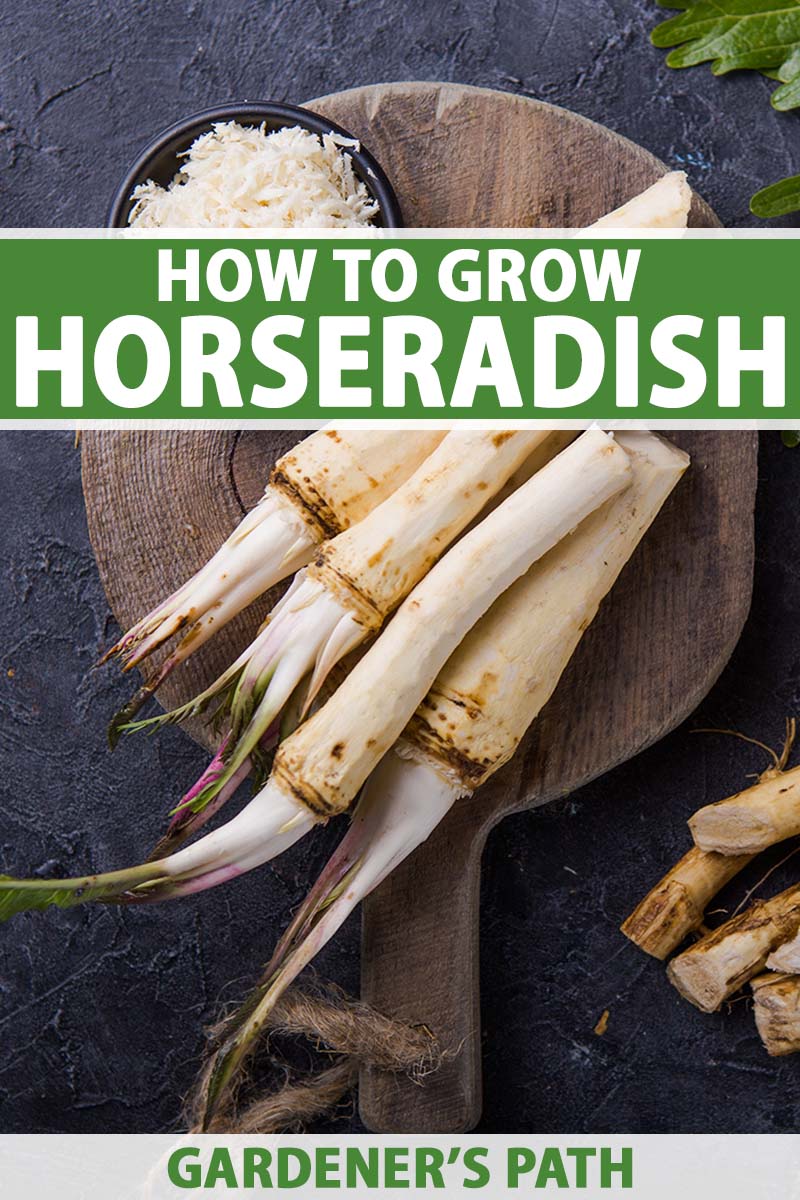
We link to vendors to help you find relevant products. If you buy from one of our links, we may earn a commission.
In addition to being popular in the kitchen, the horseradish plant has its fans – and a history – in the medicinal plant world, too.
Let’s learn more about this plant’s many uses, and then get down to business with the planting and harvesting. Here’s what we’re going to discuss:
What You’ll Learn
Horseradish isn’t what I’d call a common backyard plant, but it has been around for a long, long time.
Popular as a medicinal and edible species, we’ve been cultivating it since at least 100 AD. Let’s explore the origins of horseradish.
Cultivation and History
Horseradish is a member of the Brassicaceae family, the same group from which cabbages, broccoli, and brussels sprouts come.

And while we’d typically refer to the root as a vegetable, the medicinal and culinary applications of the leaves and flowers lead many gardeners to call this plant an herb.
Horseradish is assumed to have originated around what is considered modern-day Russia, western Asia, and southeastern Europe, which should tip you off about this plant’s cold-loving nature.
As early as 100 AD, the plant had made an appearance in De Materia Medica, the definitive guide to medicines in Ancient Greece and Rome. In the book, it was touted for easing cramps and back pain.
By the 13th century, it was being cultivated throughout the Nordic countries as a spice and a medicine.
The plant also plays a historic role starting in the eleventh century in the Passover Seder plate as one of the bitter herbs, an important tradition of the Jewish faith that continues to this day.

This aromatic came to North America during the time of European colonization, with commercial production beginning in the mid-1850s.
Horseradish sauce was one of the first condiments produced and sold in the US. Collinsville, Illinois, where it was first sold by John Henry Heinz in novel clear glass bottles to show off its quality, still calls itself the “Horseradish Capital of the World.”
The leaves, flowers, and roots of this plant have been used medicinally throughout history as everything from a cure for scurvy to improving blood flow. It has also been used as a fungicide and pesticide.
The leaves are said to be an analgesic, the flowers are made into a tea that is said to fight colds, and a compound in the root has been shown to have antibacterial properties.
The leaves emerge from the long taproot in a rosette, much like dandelions do, and they are long and dark green.
Flowers have four white petals and form at the end of the stalks.
The root grows up to a foot deep and isn’t just full of flavor, it’s healthy too. It’s packed with vitamins C and B1, as well as iron, calcium, magnesium, and potassium.
The pungent bite characteristic of the root is caused by the sulfur-containing compound allyl isothiocyanate. By the way, this compound is also responsible for “garlic breath” and is found in alliums.
If you’ve ever accidentally taken too big of a bite of horseradish-based wasabi and found yourself nearly blinded with nasal pain, you were slapped by the allyl isothiocyanate, which acts similarly to capsaicin in the body.
You could say that your sushi lunch tear-gassed you.
This compound provides protection against insects that might be tempted to take a nibble out of them.
Humans (or some of them, anyway) not only enjoy the flavor, but some are trying to harvest this compound commercially for use in pain management.
Speaking of wasabi…
A Note on Wasabi
Wasabi, sometimes called Japanese horseradish, is actually a totally different plant: Eutrema japonicum.
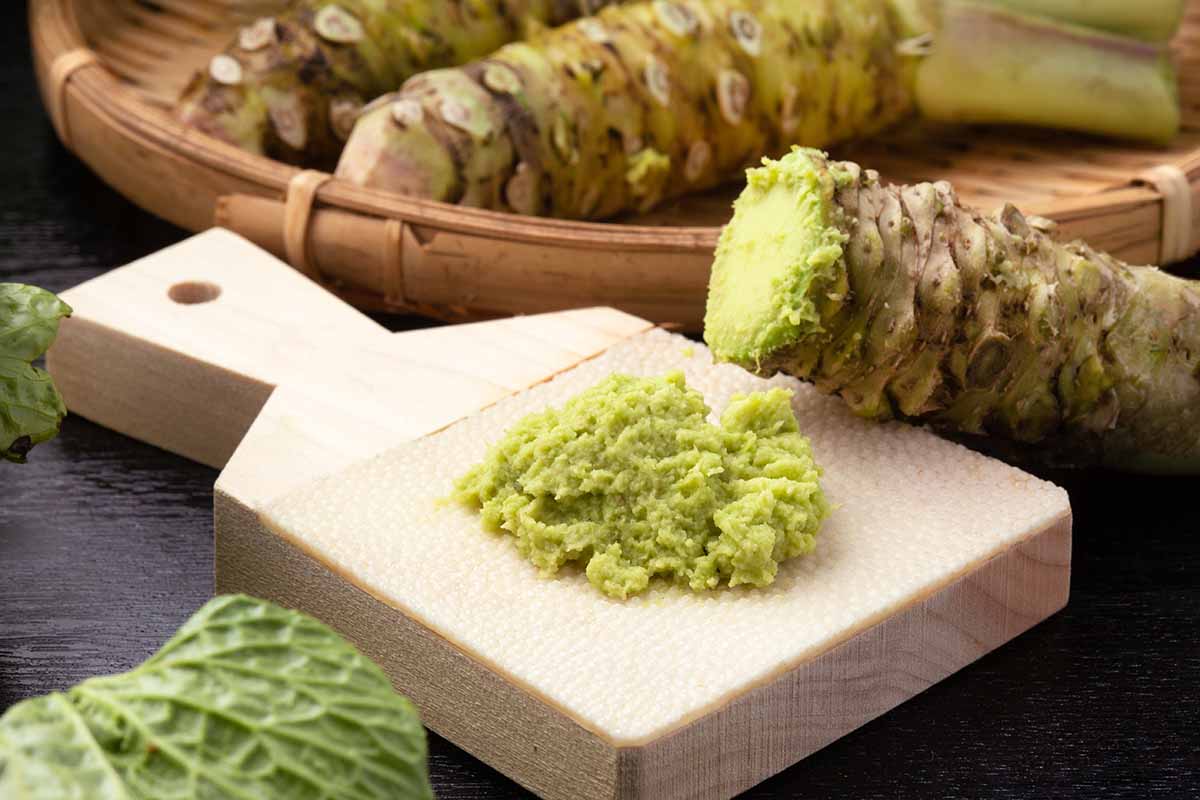
In North America, of course, we know wasabi as the fiery accompaniment to sushi and sashimi.
But because true wasabi is very difficult to cultivate outside of Japan, what is sold and served here is very rarely the real deal.
Instead, we usually get ground horseradish mixed with green food coloring and other flavorings.
Horseradish Plant Propagation
Horseradish seeds aren’t usually available to the home grower.
These plants don’t readily produce viable seeds because many plants are self-incompatible and will reject pollen from themselves.
This is a smart evolutionary strategy because it diversifies the gene pool, but it’s not so great for our seed propagation efforts.
It’s possible to breed unrelated clones and produce viable seed, but since using sets (or crowns) works so well, that’s how it’s mostly done.
Horseradish is propagated by taking root cuttings about as thick as a pencil, which are sometimes called “sets.”
If you purchase sets, the grower will generally ship them with the side that should be facing down cut at an angle and the side that should be up is flat.
If you harvest your own, you might want to trim them in a similar way to remind yourself how to plant them.
And in case you were wondering, yes, you can plant the ones you buy at the grocery store.
Space the sets one foot apart, placing them at a 45-degree angle, with the square-cut end higher than the angled end.
Ensure that the square cut ends are all facing in the same direction so that the leafy tops will grow evenly spaced.
Cover the sets with two inches of soil and water well. Keep the soil moist as the plants develop.
When you harvest the roots, cut away a piece that includes a root and one leaf crown and replant it for a perpetual harvest.
How to Grow Horseradish Plants
In contrast to its spicy-hot nature, this plant is fond of cool conditions. It does well in USDA Growing Zones 2 to 9, but time your plantings according to local weather patterns.
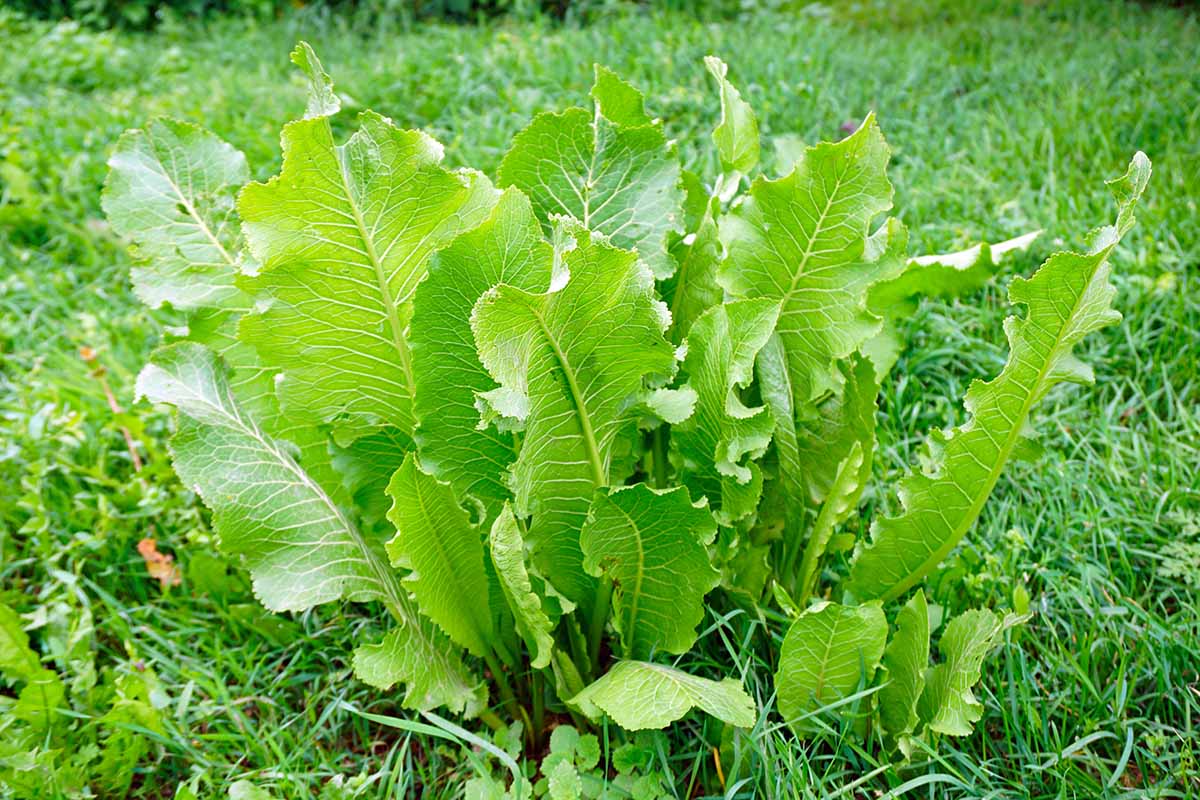
This plant probably won’t survive a hot summer in Zone 9 but will make a perfect winter crop there. In Zone 2, late summer might be your best option.
Aim to plant when you’ll have 140 days when the daytime high temperatures will range from 45 to 75°F. The root tastes better after a frost has killed the leaves, so take that into consideration. But a frost isn’t necessary to produce a tasty veggie.
Before planting, work lots of well-rotted compost at least six inches deep into the soil. If you’re growing a larger cultivar, amend the soil as deep as the root will grow. Compost improves drainage and water retention while adding nutrients.
Remove each and every rock you encounter as you go. The soil should have a pH between 6.0 and 7.5.
If this is just too much digging and amending for you, plant in a raised bed or container filled with loose, loamy, water-retentive soil.
Growing in a container is also smart if you’re worried about this plant spreading where you don’t want it to.
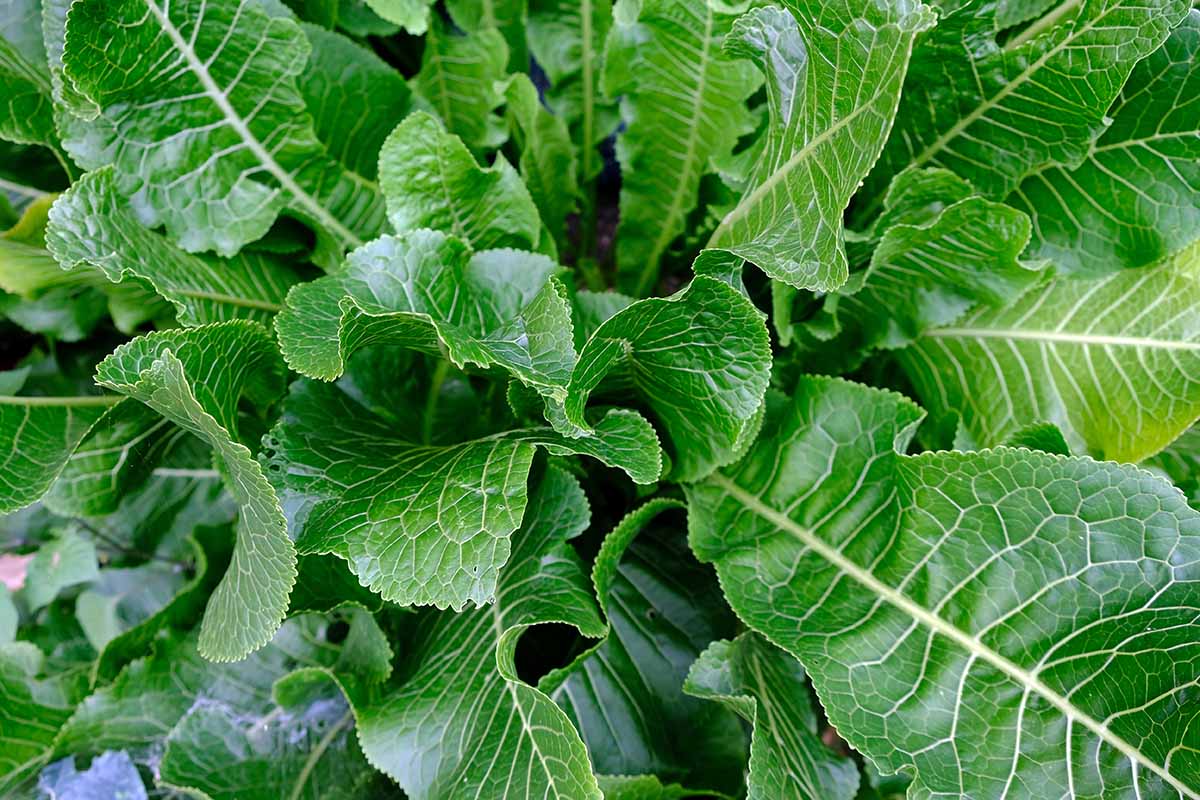
Whichever way you go, just know that ensuring you have loose soil will pay off big at harvest time. Rocks will cause distorted growth and heavy soil will result in a smaller, tough root that might break as you try to take it out of the ground.
Plant sun-loving horseradish somewhere that will receive at least eight hours of direct sunlight per day.
Another consideration: these plants can grow as tall as three feet, and their large leaves may shade out surrounding vegetation. If you live somewhere that will likely be hotter than what this plant prefers, give it a little afternoon shade.
While horseradish is drought tolerant, the roots can become woody and weak-flavored if they go for too long without water.

If rain is scarce, give the plants one to two inches of water once a week. But take care not to give them too much water, because the roots will become soft and have a bitter flavor.
Err on the side of providing more water rather than less. If you’ve ever grown a tomato, horseradish likes similar moisture levels. If the leaves start to droop or even turn dry, you’ve let the soil dry out too much.
If you have a rain gauge, you can rely on that to tell you when to water. But I like to use a moisture meter or simply stick my finger into the soil.
That’s because you never know if the soil is drying out more quickly because of a hot spell with lots of wind, or if one part of the garden is drying out faster than another.
Add water when the top inch registers as dry.
How you water is as important as how much you water. It should be done infrequently but deeply. You want that moisture getting all the way down below the long taproot.
Place an inch of straw, leaf, or shredded bark mulch around but not touching the plants to suppress weeds and retain moisture.
Unless you’ve done a soil test and your earth registers as deficient in something, feed your plants four and eight weeks after planting with a veggie-specific food or any mild, balanced fertilizer.
If you ask me, I’ll always recommend Down To Earth’s Vegetable Garden fertilizer. It has an NPK of 4-4-4 and comes in a compostable box.
Down to Earth Vegetable Garden Fertilizer
If you’d like to grab some for your garden, Arbico Organics carries it in one-, five-, and 15-pound options.
Keep the planting area as free of weeds as possible, and pluck off any brown leaves.
If your plants go to flower, just enjoy the show. There’s no reason to pinch them off as with other herbs unless you want to eat them. They make a pretty impressive addition to a meal.
Growing Tips
- Plant in full sun but be aware that horseradish can grow tall and shade nearby plants.
- Horseradish needs about two inches of water per week or more whenever the top inch dries out. Water deeply.
- Fertilize four and eight weeks after transplant with a mild, balanced fertilizer.
Horseradish Cultivars to Select
Horseradish plants are divided into three general types: heart-shaped, intermediate, and tapered base. This refers to the shape of the leaves that attach to the petiole.
You can also broadly categorize them as common or bohemian. The “common” type has broad, crinkled leaves and what’s generally considered a superior-quality of root.
“Bohemian” types have narrow, smooth leaves and somewhat lower root quality, but these offer better resistance to white rust disease.
Some retailers simply describe their plants as generic horseradish, as you’ll find at Fast Growing Trees. Generally, these will be the common type.
Back in the day, it was hard for the home grower to get their hands on the few cultivars out there.
Now, with more people showing interest in unusual plants, you can often find them at specialty retailers. Here are a few to be on the lookout for:
Big Top Western
‘Big Top Western’ is vigorous, adaptable, and less susceptible to diseases than other types. It gets its name from its abundant foliage, which has several benefits.
First, if insects start chomping on your plants, there are plenty of leaves to keep feeding the all-important root.
Second, there are more leaves and that means more nutrients to grow a big, healthy root. It can even produce in partial shade, though the root will be smaller.

This cultivar is resistant to rust and bacterial spot.
Country Creek Acres carries this cultivar, which they sell on Amazon in one-ounce sizes.
Czechoslovakian
Sometimes styled as “Czech,” this cultivar has mild roots. If you like the flavor of horseradish but you don’t want to deal with all that heat, search this one out.
Though it’s newer on the market and mostly grown by commercial growers, you can find it at nurseries that specialize in unusual veggies.
This bohemian clone was brought to the US by Czech immigrants.
Improved Bohemian
‘Improved Bohemian’ is one of the most common cultivars grown commercially, alongside its parent, ‘Bohemian.’
It’s a little harder for the home grower to get their hands on, but it’s out there.
This one has more disease resistance and slightly larger roots than ‘Bohemian,’ which has a classic, hot bite.
Maliner Kren
This bohemian type, which you can purchase in five bare root packs at Burpee, has been around for a long time because it keeps winning over new generations of fans with its vigorous growth habit, snow-white flesh, and the classic “horsey” taste.
Watch out for viral diseases, as this plant is susceptible.
You’ll often see this cultivar called “common” horseradish, but that doesn’t mean it’s a common type.
Those who refer to it this way simply mean this one is found all over the place and it’s one of the most popular options.
Variegata
Most people wouldn’t call horseradish attractive. It’s a little boring looking, to be honest. But ‘Variegata’ features eye-catching pure white, green and white, and pure green leaves.
‘Variegata’ won’t typically start developing its white and green leaves until the plant is slightly more mature, but once it does, these make a beautiful ornamental addition to the garden.
This cultivar can tolerate partial sun, so grab one if you don’t want to grow yours in full sun.
The root of this common type has the classic flavor you’re looking for.
Managing Pests and Disease
Likely due to its pungency, few pests affect these plants, but keep an eye out for flea beetles and beet leafhoppers (Circulifer tenellus).
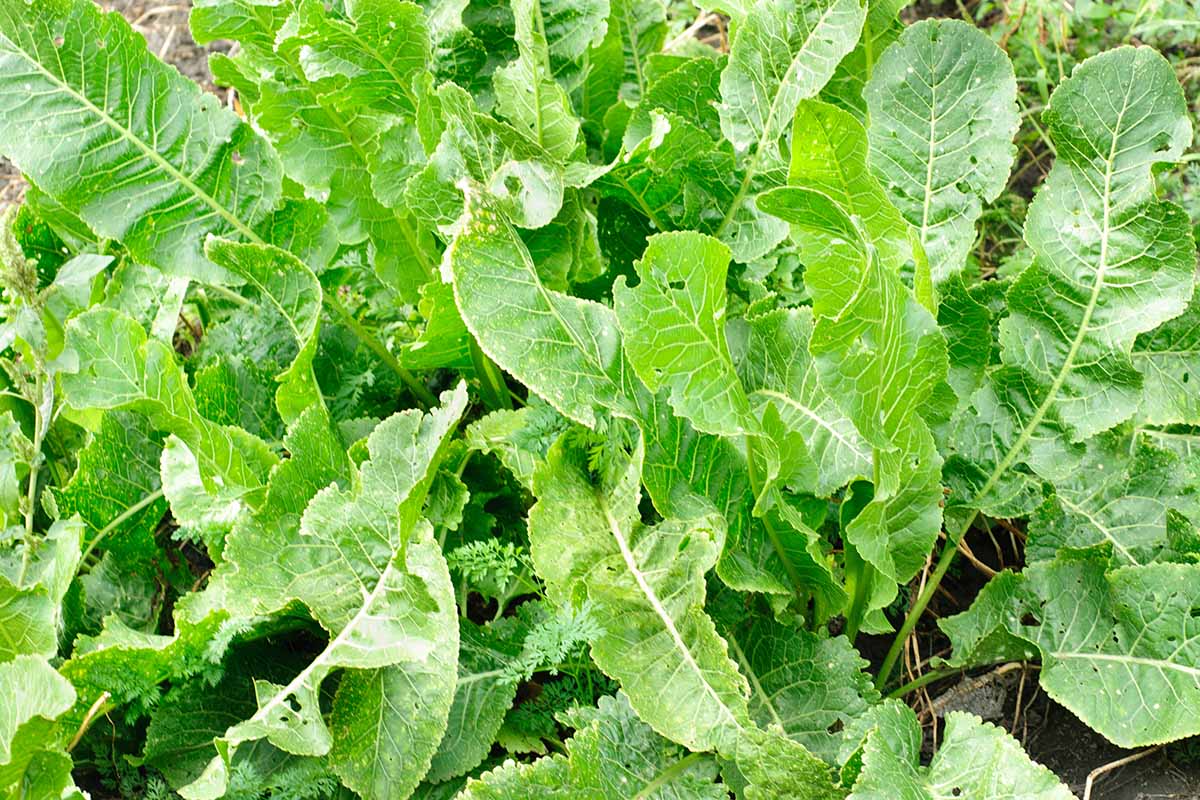
Both feed on the leaves, and while this can make the leaves ugly, they also spread disease. Treat these bugs with insecticidal soap.
Unlike pests, disease can be a serious issue for horseradish. Like most brassicas, fungi just can’t get enough of these plants. Here are the big ones to be aware of:
Leaf Spot
Leaf spot is caused by Cercospora amoraciae fungi. It results in small, purple-ringed spots and thrives in cool, humid conditions.
Learn more about Cercospora identification and control in our guide.
Rust
Rust in horseradish plants – and all crucifers – is caused by an oomycete called Albugo candida. It causes little white fungus-like spots on the leaves or stems of the plant.
When these pustules “pop” during cool weather at temperatures between 55 and 75°F, they release pathogens that travel on wind or water onto other plants.
If your plant is infected, trim off any infected leaves. Use extreme caution not to splash water on the plants – water at the soil level only to prevent infection or prevent further spread.
When it’s time to harvest, pull up the entire plant and dispose of all the green parts – don’t put them in the compost. You can still eat the root but don’t replant any part of an infected specimen.
Turnip Mosaic Virus
Sure, the name says “turnip” in it, but turnip mosaic virus (TuMV) infects horseradish plants, too. When infected, the leaves will develop angular yellow spots and may eventually die. You might also see black streaks on the stems.
This disease is spread by pests, so avoiding it means controlling them.
Once infected, there’s nothing you can do but pull the plants and dispose of them. Either seal them in a bag and throw them out, or burn them.
Learn more about turnip mosaic virus in our guide.
Harvesting Horseradish Roots
Harvest the long, white, tapered roots in late fall or winter, once frost has killed the leaves.
With luck, this will be just in time to make a fabulous sauce for a holiday prime rib, which you can learn all about in this guide from our sister site, Foodal.
Alternatively, if you like more spice, you can harvest in early spring just before new sprouts form.
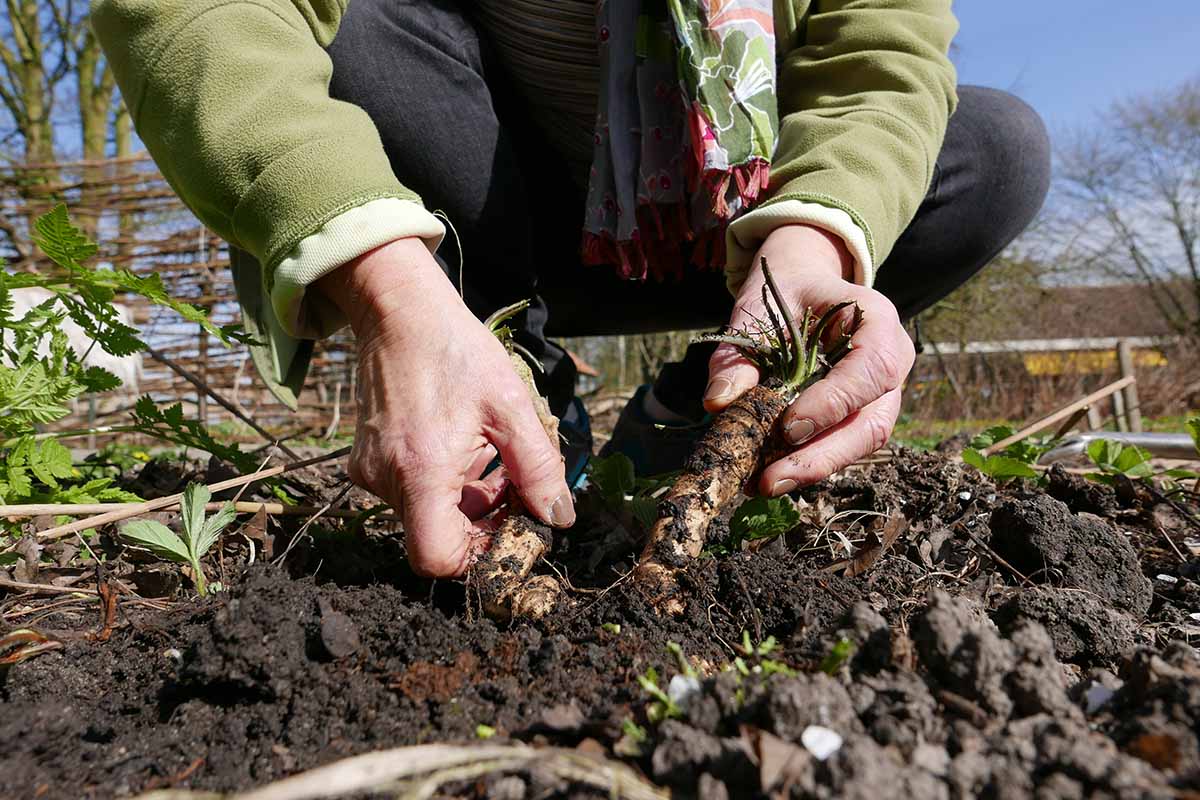
Gently dig up your plants and cut off the large, thick roots to use. Leave some of the smaller root pieces in the soil to start new plants for the next year.
You can keep what you’ve harvested in the refrigerator for a few weeks. Or store roots in damp sand or sawdust in a cool, dark cellar for up to 10 months.
And speaking of leaves, you can actually harvest the tender, young ones and add them to salads for a slightly spicy kick.

When harvesting, be cognizant of the fact that if you unintentionally leave behind a chunk of root in the garden, it will turn into a new plant.
That’s how this plant becomes invasive. Don’t till this plant under when you’re done with it or you’ll be dealing with a lot of horseradish that you didn’t plan on cultivating.
Storage and Preserving Horseradish Roots
Once harvested, brush the roots clean but don’t wash them.
Place them in a ventilated bag in a cool, dark place or in the refrigerator. Leave just the ends of the leaves in place. Roots can last several months this way.
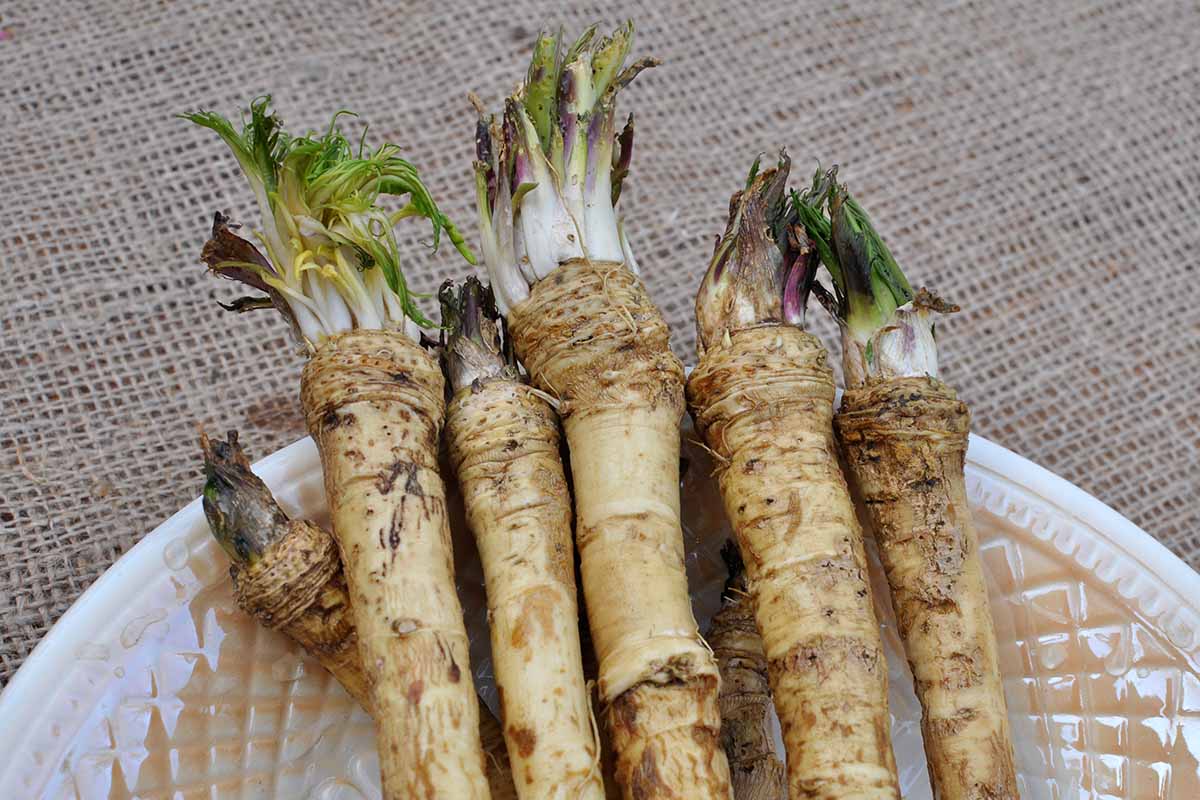
When you’re ready to consume the roots, peel and grate them. Or you can chop them into one-inch chunks, or run them through a food processor.
Grated or chopped horseradish can be kept in an airtight container in the refrigerator for one to two weeks.
You can also wash and grate the root and freeze it in small batches. This will last for up to six months in the freezer, but you will lose much of the pungency.
Add two or three teaspoons of vinegar or lemon juice per cup of grated horseradish to further extend the shelf life of the product. Note that adding vinegar immediately after processing reduces the pungency of the root.
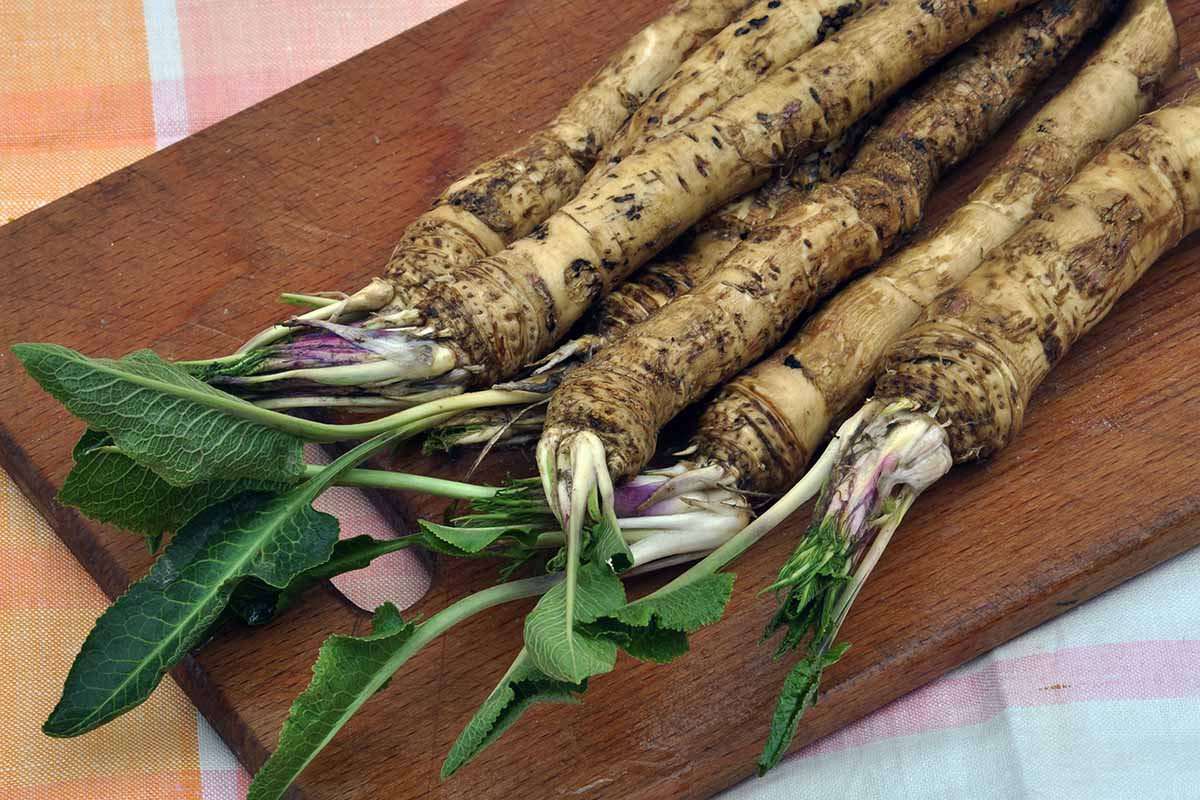
Also, consider opening windows or doors or running ventilation fans as you cut or grate the horseradish root, because the aroma is quite strong.
You can also dry both the leaves and the roots.
Wash and slice the roots thin, place them on a baking tray, and cook at the lowest setting in your oven. Or, put them in a dehydrator.
You can do the same with the leaves, minus the slicing. Just wash the leaves before drying.
Find more tips on drying herbs here.
Recipes and Cooking Ideas
There are so many delicious ways to consume this spicy root. Making a sauce, which involves combining the grated root with sour cream, salt, and pepper, is just the beginning.
First, enhance your cocktails – of either the beverage or the shrimp variety – with homegrown horseradish. Your parties will be standing-room only.
Foodal’s spicy Bloody Mary recipe is a great place to start, especially if you’re a fan of DIY – and if you’re growing hot peppers and tomatoes in the garden this season alongside the horseradish…
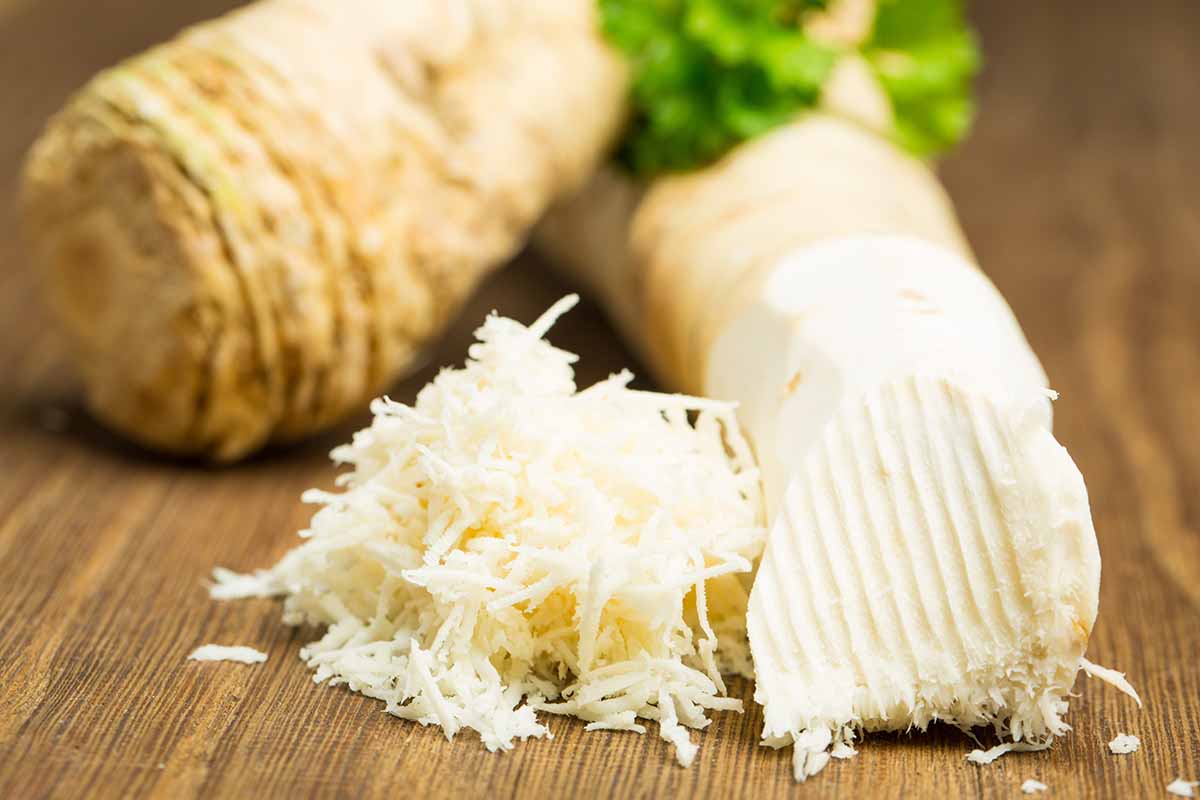
In addition to this flavorful homegrown root, you’ll love juicing your own garden tomatoes and infusing vodka with backyard jalapenos to prep and serve this craft cocktail at your next brunch gathering.
Use the shredded root to spice up hummus or scrambled eggs. Slice it thinly into green or potato salads. It’s also delicious shredded or grated as a topping for fish.
Quick Reference Growing Guide
| Plant Type: | Herbaceous perennial | Water Needs: | Moderate |
| Native to: | Russia, southeastern Europe, western Asia | Maintenance: | Low |
| Hardiness (USDA Zones): | 2-9 | Tolerance: | Some drought, freezing temperatures |
| Bloom Time/Season: | Fall, winter, spring | Soil Type: | Loose, rich |
| Exposure: | Full sun, partial sun | Soil pH: | 6.0-7.5 |
| Time to Maturity: | 140 days | Soil Drainage: | Well-draining |
| Spacing: | 12 inches | Attracts: | Pollinators |
| Planting Depth: | 2 inches (transplants) | Companion Planting: | Jerusalem artichokes, potatoes, rhubarb |
| Height: | Up to 4 feet | Avoid Planting With: | Other brassicas |
| Spread: | 2 feet | Family: | Brassicaceae |
| Growth Rate: | Moderate | Genus: | Armoracia |
| Common Pests and Diseases: | Beet leafhoppers, flea beetles; leaf spot, rust, turnip mosaic virus | Species: | Rusticana |
Spice Your Garden Up
The many gifts of horseradish include medicinal, flavorful leaves and flowers, and a one-of-a-kind punch of flavor from the root. You can even get a little bit of ornamental value from the variegated type.
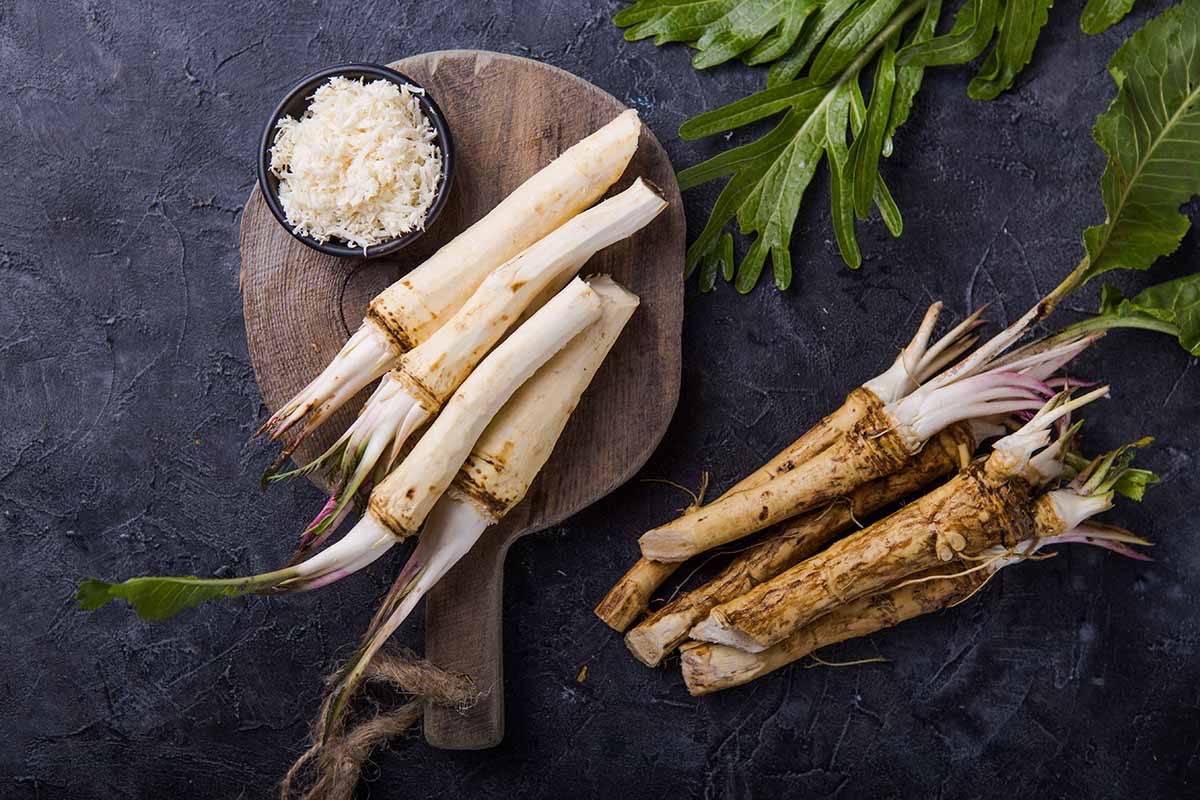
There are so many benefits to growing it in your own backyard – and you’ll love the pungent punch of flavor that it adds to beverages, condiments, and your favorite dishes!
Have you ever grown horseradish? Any tips for others thinking of taking the plunge? Please share in the comments section below.
If you liked this guide and you’re interested in growing more brassicas, we have a few guides that might be worth checking out:
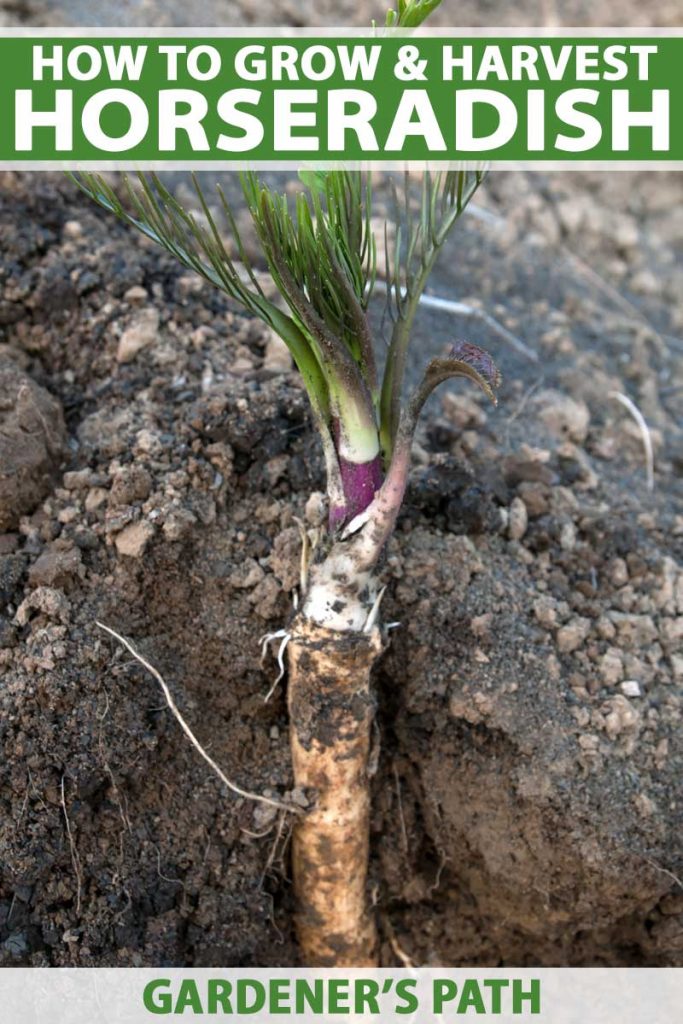
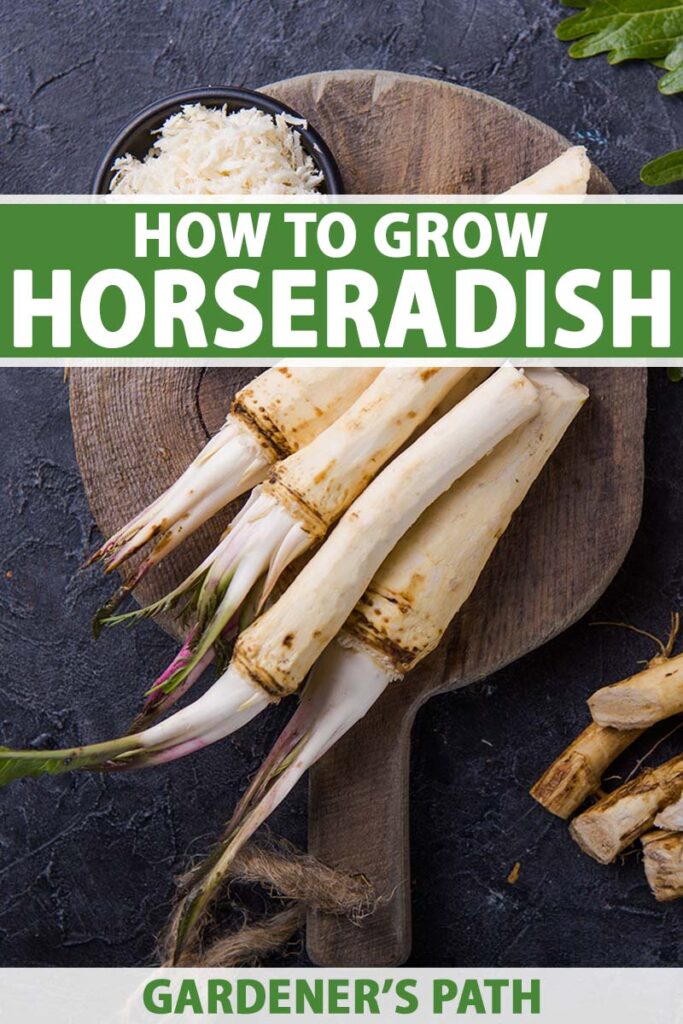
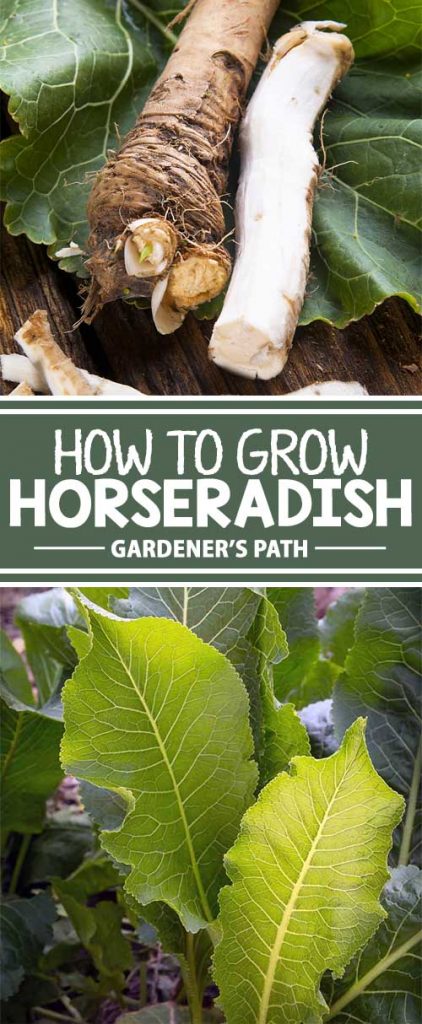
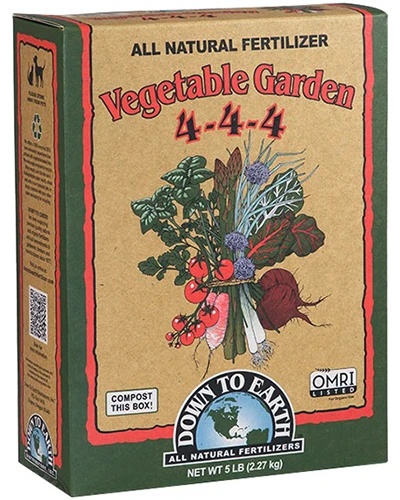
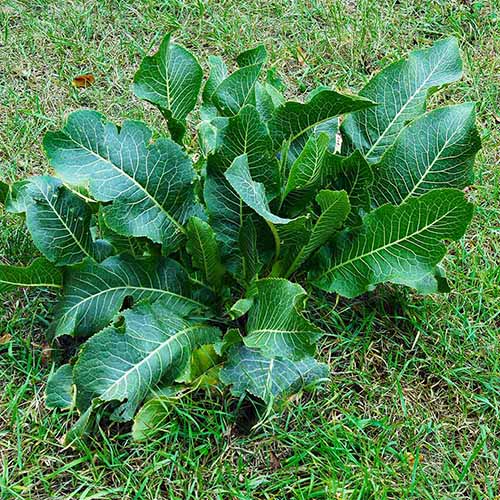
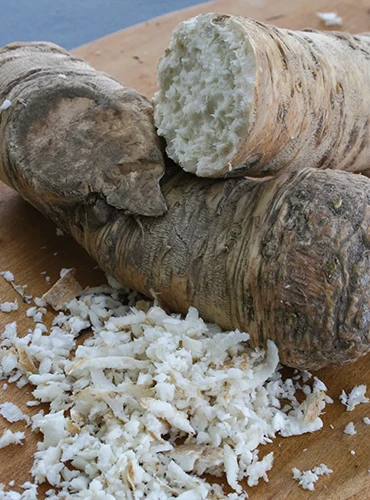
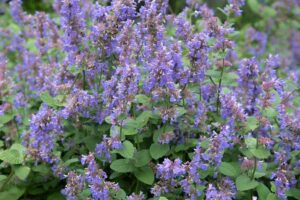
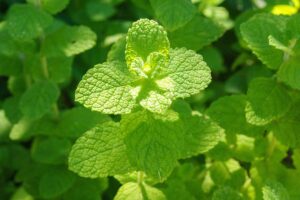
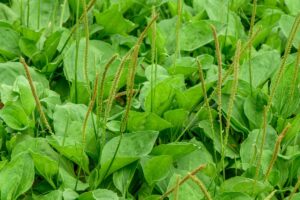
Horseradish grows like a weed on our farm north of Edmonton. My mother in law planted it years ago, and I’ve been trying to contain it to one part of the garden. When you drive the backroads you can tell where the original farmhouses were, because the horseradish is growing wild, and spreading down the ditches.
Jennifer, that is so interesting. Had no idea it just grew like that, wild! Thanks for sharing.
Do deer like horseradish ?
Hi nhigh,
Thanks for reading. For the most part, deer appear to leave horseradish plants alone. However, I do know of one instance where they chowed down on the leaves. I guess you’ll have to find out if deer in YOUR area like YOUR horseradish!
Hi, just dug up my horseradish and it looks like this. Very thin roots and not too useable. Do you have any idea what I have done wrong? I am in Melbourne Australia. It has been growing in a veg patch and been watered and fertilised regularly over the last year. Leaves were full until last week when cabbage moth caterpillars ate them.
I would like to try to use some root but how should I replant them for next year?
Thanks for your help
Abundant foliage with thin roots below ground may mean too much nitrogen in the soil is to blame. Fertilizing with a balanced mix or a lower nitrogen fertilizer is good for horseradish at planting time and at the end of the season when plants go dormant, but it’s not typically required throughout the growing season. Hopefully you can still replant cuttings from what did grow. Hope this helps!
I was able to buy 4-5 little shoots last spring from a Facebook Marketplace poster. It has been a fun summer/fall watching these wilted and quite pathetic plants grown to nearly four feet tall! Just waiting for the frost! But I question: can I harvest a few roots this first year? The woman who sold them to me told me to wait one year.
So happy to hear that your plants have taken off, Jane! For edible root crops like these, I know it can be hard to wait, but it’s best to hold off for at least one full year, or preferably two, before pulling your first harvest from the ground so your plants can become established. Harvest annually after that, particularly in mid to late fall, after the foliage has died back but before the ground has frozen.
To start horseradish in your garden only a small piece of the top end of the roots is needed. I harvest mine, cut 1″ below the leaves, trim leaves close to root then cover the root in potting soil. I place the pot in the greenhouse or by a sunny window. By spring I have hundreds of the starter plants with nice leaves that sell on the first day of the farmers market.
One thing to watch out for is voles. I had a beautiful crop growing last year and was looking forward to fermenting some fresh root. Just before harvest I noticed the leaves dying. Upon further inspection a vole was eating the roots. Moved them to a raised bed to keep a better eye on them.
Thanks for the tip, Jason. It’s true, voles can feed on the roots. I have always found that voles go for other root crops before they head to my horseradish, but that doesn’t mean they won’t feed on horseradish roots. Raised beds and containers are life (root) savers!